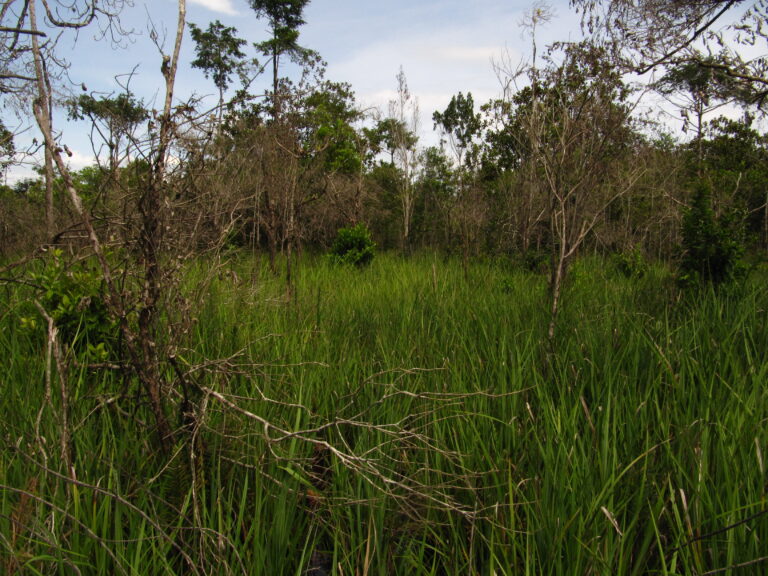Project Description
Globally, peatlands contain stored C equivalent to the amount that would be emitted to the atmosphere from burning fossil fuels at the 2007 annual global rate for the next 75 years. Tropical peatlands contain up to one-third of this peatland C but are vastly understudied compared to northern peatlands. It is unclear how resilient these ecosystems and their C stores are. Tropical peatlands also provide a wide range of critical ecosystem services but are uniquely threatened by widespread drainage and climate change. The fragility of tropical peatlands is of direct relevance to human lives, as recently underscored by the impacts of extensive peat fires in SE Asia. This project will quantify how tropical peatlands have responded to climate change and human impacts in the late Holocene which will help us understand their response to present and future climate change.
A high-resolution multiproxy approach (pollen, testate amoebae, geochemistry) will be used to reconstruct the ecological and hydrological dynamics of selected tropical peatlands, and robust chronological control will be achieved through a comprehensive dating strategy (radiocarbon, 210Pb). The palaeoenvironmental data will be used to provide definitive answers to key questions regarding tropical peatland resistance and resilience to past climatic events (e.g. droughts) and human disturbance (e.g. burning). Our palaeo-data will also provide important baseline information regarding the potential vulnerability of tropical peatlands to climate change and fire, and their recovery.
Hypotheses to be tested:
(H1) Tropical peatlands exhibit a degree of resilience to past drought and anthropogenic disturbance, through autogenic ecohydrological feedbacks inherent in peatland development;
(H2) Tropical peatlands have undergone rapid ecological and hydrological changes in response to twentieth century climate change;
(H3) Recovery of tropical peatlands from droughts depends on the frequency and magnitude of the climate forcing.
CANDIDATE BACKGROUND
Essential skills: Scientific data production, understanding of climate change, data analysis
Desirable skills/experience: Use of R, analysis of microfossils, climate modelling
Photo credit: Graeme Swindles
Supervisors
Graeme SwindlesPrimary Supervisor: | Profile: Graeme Swindles Email: g.swindles@qub.ac.uk Institution: Queen's University, Belfast Department/School: School of Natural and Built Environment |
Tim MighallSecondary Supervisor: | Profile: Tim Mighall Email: t.mighall@abdn.ac.uk Institution: University of Aberdeen Department/School: School of Geosciences |
Maarten BlaauwAdditional Supervisor: | Profile: Maarten Blaauw Email: maarten.blaauw@qub.ac.uk Institution: Queen's University, Belfast Department/School: School of Natural and Built Environment |
Additional Supervisor: | Professor Bronwen Whitney, Northumbria University Email: Bronwen Whitney bronwen.whitney@northumbria.ac.uk |
References
Baird, A.J., Low, R., Young, D., Swindles, G.T., Lopez, O. and Page, S. 2017. High hydraulic conductivity explains the vulnerability of the carbon store in drained tropical peatlands. Geophysical Research Letters 44, 1333-1339.
Swindles, G.T., Morris, P.J., Whitney, B., Galloway, J.M., Gałka, M., Gallego-Sala, A., Macumber, A.L., Mullan, D., Smith, M.W., Amesbury, M.J., Roland, T.P., Sanei, H., Patterson, R.T., Sanderson, N., Parry, L., Charman, D.J., Lopez, O., Valderamma, E., Watson, E.J., Ivanovic, R.F., Valdes, P.J., Turner, T.E. and Lähteenoja, O. 2018. Ecosystem state shifts during long-term development of an Amazonian peatland. Global Change Biology 24, 738-757.
Garcin, Y. et al. 2022. Hydroclimatic vulnerability of peat carbon in the central Congo Basin. Nature. 612, 277-28.
QUADRAT Themes
- biodiversity
- earth-systems
- environmental-management






















































